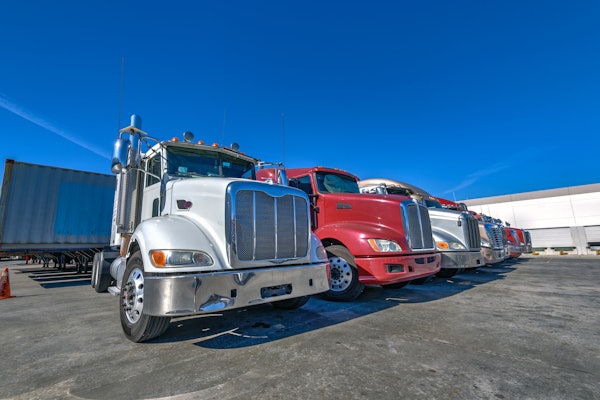Analysts and vendors expect that carriers will adopt trailer-tracking systems at a rapid pace in 2007 and that the technology will see strong growth for at least a couple more years.
“The demand for trailer-tracking services in its various forms continues to grow steadily and has been ramping up for the last two years,” says David Sward, general manager of products and services for GlobalWave, a division of TransCore. “Everyone in this business is seeing increased demand. There is increased awareness among carriers, both private and for-hire LTL and truckload, in trailer tracking.”
In September 2005, Clem Driscoll – president of C.J. Driscoll and Associates – estimated the number of installed trailer-tracking units to be 260,000. Driscoll’s research and consulting firm, which specializes in GPS-based products and services, predicted this number would increase to 415,000 in 2006 and continue to 575,000, 750,000 and 900,000 in years 2007 through 2009.
But these estimates appear to be conservative. After reviewing the actual number of trailer-tracking systems installed in 2006, Driscoll says that 450,000 is more accurate. The number of installed units by vendors is about 100,000 for Qualcomm, 115,000 for SkyBitz and 100,000 for Terion, he says.
In January, GE Asset Intelligence – a division of GE Equipment Services – acquired Terion, making it the largest provider of trailer-tracking services, the company says. The acquisition added to the approximately 80,000 units GE Asset Intelligence had in the field.
The remaining 55,000 units in service in the United States are divvied up among vendors such as TransCore and AirIQ, Driscoll says. On a global scale, the market is much different: Of the 150,000 units worldwide that use satellite transceivers, 110,000 are GlobalWave units, according to TransCore.
Numbers alone do not explain why trailer-tracking services continue to grow so rapidly. With advanced two-way communications, onboard computing and sensors, today’s systems can capture a full range of trailer and cargo status. The most common reason fleets use trailer tracking is to reduce operational costs by knowing the whereabouts and status of their trailers – both through scheduled and real-time reporting, Sward says.
The cost savings from increasing trailer utilization is fairly easy to justify for larger fleets with more than 1,000 trailers, Driscoll says. An appealing benefit for fleets of all types and sizes is the impact the technology can have on the top line. Fleets can track trailer detention and bill customers for using a trailer for storage, simply by using additional cargo and door sensors to track the precise moment a customer loads or unloads a trailer.
Today, technology providers who now find themselves in a competitive landscape for the remaining untracked trailers are seeking to increase their value proposition through additional reporting content to their base service.
SkyBitz recently announced integration with Stemco’s TracBAT Mileage Sensor, which is installed on a trailer’s hub meter. Using radio frequency transmission, TracBAT sends mileage to the SkyBitz onboard GLS 200 system. Fleets now can get an updated mileage report with each location report, says Roni Taylor, executive vice president for SkyBitz. Location reports can be configured using SkyBitz’s Smart Sensor technology to be sent at each departure, stop and arrival. Fleets also can use SkyBitz’s Insight online application to pull mileage reports by trailer number on any date range – daily, weekly or monthly.
Mileage reports are especially useful for trailer leasing companies, Taylor says, and for fleet maintenance by scheduling trailer preventative maintenance schedules based on mileage instead of the calendar.
Another value-added report is tire air pressure. For example, some fleets are using the Meritor Tire Inflation System by PSI in conjunction with their trailer-tracking systems. MTIS provides a 12-volt signal from its control box to the specified trailer-tracking system for the fleets’ trailers or chassis. The supplier of the trailer-tracking device provides the necessary program software to recognize a tire inflation problem event and transmit it to the fleet, who then can determine a convenient repair plan for the suspect tire.
Some of the biggest technology breakthroughs in trailer monitoring in the past two years are in power management and battery life. In October 2005, TransCore introduced Slap & Track, a low-cost sealed unit with batteries that last more than five years. The device installs in less than 15 minutes and is easy to move to different trailers, Sward says.
As part of its release of Slap & Track, TransCore developed a power-efficient core modem it now uses for its Sense & Track, which is designed for customers that want to add trailer monitoring applications such as door, cargo and temperature sensors.
“We’ve come to the conclusion that in trailer tracking, there is not a one-size-fits-all solution,” Sward says. “We kept the cost down by modularizing the product and customizing different solutions.”
Technology breakthroughs, combined with competitive costs, have lowered the barrier to adoption for fleets. Just as important, the vendors in the market have proven that the business model for trailer tracking works, adding stability to fleets’ technology investments.









